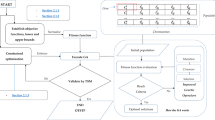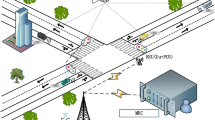Abstract
The off-ramps of urban expressways can assume various forms. Compared with other countries, many off-ramps in China have special Chinese characteristics; for example, the off-ramps are extremely short and connected to urban roads and intersections within a short distance. Thus, many foreign control methods may not be suitable for use in China. This paper provides a dual-phase signal timing optimization model for an intersection connected to the off-ramp of an urban expressway that has special Chinese characteristics. This model is solved by an improved genetic algorithm. To better evaluate traffic conditions, this paper also establishes methods by which stranded vehicles can be identified and the traffic flow at intersections can be predicted. The performance of the optimized signal timing is tested with PTV Vissim software, and the timing plan is calculated by MATLAB using an actual scenario in Xi’an, China. The optimized effect of the proposed model is tested under different flow conditions by changing the input traffic flow of the intersection. The results show that at the peak time, the stops, delays and queue lengths of the whole intersection are reduced by 29.0%, 27.8% and 23.7%, respectively, compared with the original plan and by 7.7%, 14.5% and 11.9%, respectively, compared with the plan from the single-phase model. This dual-phase model can prevent congestion from spillback onto urban expressways as well as reduce delays and stop times at intersections, especially in a supersaturated state. In general, this model can be used to address signal timing in ordinary urban intersections.










Similar content being viewed by others
Code Availability
Available.
References
Sims, A.G.; Dobinson, K.W.: The Sydney coordinated adaptive traffic (SCAT) system philosophy and benefits. IEEE Trans. Veh. Technol. 29(2), 130–137 (1980). https://doi.org/10.1109/t-vt.1980.23833
Jie, Y.; Jidong, W.: Oversaturated intersection control method based on cell transmission model. J. Shandong Jiaotong Univ. 25(03), 30–37 (2017)
Hunt, P.B.; Robertson, D.I.; Bretherton, R.D.; Winton, R.I.: Scoot—a traffic responsive method of coordinating signals. TRRL Laboratory Report (Transport and Road Research Laboratory, Great Britain) (1981)
Gartner, N.H.: OPAC: a demand-responsive strategy for traffic signal control. Transp. Res. Rec. 1983(906), 75–81 (1983)
Li, Z.; Chang, G.-L.; Natarajan, S.: An integrated off-ramp control model for freeway traffic management. In: 15th World Congress on Intelligent Transport Systems and ITS America Annual Meeting 2008, November 16, 2008—November 20, 2008, New York, NY, United states 2008. 15th World Congress on Intelligent Transport Systems and ITS America Annual Meeting, pp. 868–879. Intelligent Transportation Society of America (2008)
Yang, X.; Lu, Y.; Chang, G.-L.: Dynamic signal priority control strategy to mitigate off-ramp queue spillback to freeway mainline segment. Transp. Res. Rec. 2438, 1–11 (2014). https://doi.org/10.3141/2438-01
Li, Z.; Tao, R.: Integrated control of freeway interchange model based on enhanced cell transmission model. Transp. Res. Rec. 2259, 179–191 (2011). https://doi.org/10.3141/2259-17
Yin, S.; Xu, R.; Zhang, Y.; Li, Z.: Signal control strategies for bottleneck area on urban expressway. J. Transp. Syst. Eng. Inform. Technol. 12(2), 27–33 (2012)
Chen, A.; Chootinan, P.; Ryu, S.; Lee, M.; Recker, W.: An intersection turning movement estimation procedure based on path flow estimator. J. Adv. Transp. 46(2), 161–176 (2012). https://doi.org/10.1002/atr.151
Lee, S.; Wong, S.C.; Pang, C.C.C.; Choi, K.: Real-time estimation of lane-to-lane turning flows at isolated signalized junctions. IEEE T Intell. Transp. 16(3), 1549–1558 (2015). https://doi.org/10.1109/tits.2014.2365876
Jiao, P.P.; Li, Z.H.; Liu, M.Q.; Li, D.Y.; Li, Y.W.: Real-time traffic signal optimization model based on average delay time per person. Adv. Mech. Eng. 7(10), 1687814015613500 (2015)
Murat, Y.; Cetin, M.: A new perspective for saturation flows at signalized intersections. Period. Polytech. Civ Eng 63, 3–9 (2019). https://doi.org/10.3311/ppci.11344
Ali Silgu, M.; Goksad Erdagi, I.; Berk Celikoglu, H.: Analyzing network-wide effects of cooperative adaptive cruise control without traffic signal control at intersections. In: Moreno-Díaz, R., Pichler, F., Quesada-Arencibia, A. (eds.) Computer Aided Systems Theory—EUROCAST 2019, pp. 79–86. Springer International Publishing, Cham (2020)
Ali Silgu, M.; Akyol, G.; Berk Celikoglu, H.: Analysis on pedestrian green time period: preliminary findings from a case study. In: Computer Aided Systems Theory—EUROCAST 2019, Cham 2020. Computer Aided Systems Theory—EUROCAST, pp. 121–128. Springer International Publishing, Berlin (2019)
Akyol, G.; Silgu, M.A.; Çelikoglu, H.B.: Pedestrian-Friendly Traffic Signal Control Using Eclipse SUMO. In: Melanie Weber, L.B.-W.; Hilbrich, R.; Behrisch, M. (eds.) SUMO User Conference, pp. 101–106. EasyChair (2019)
Erdağı, İ.G.; Silgu, M.A.; Çelikoğlu, H.B.: Emission effects of cooperative adaptive cruise control: a simulation case using SUMO. EPiC Ser. Comput. 62, 92–100 (2019)
Wen, K.; Qu, S.; Zhang, Y.: A control-oriented macroscopic traffic flow model for urban diverse intersections. In: 2009 International Asia Conference on Informatics in Control, Automation and Robotics, 1–2 Feb. 2009, pp. 62–66 (2009)
Tiriolo, M.; Adacher, L.; Cipriani, E.: An urban traffic flow model to capture complex flow interactions among lane groups for signalized intersections. Proc. Soc. Behav. Sci. 111, 839–848 (2014). https://doi.org/10.1016/j.sbspro.2014.01.118
Chen, Y.; Yuan, M.; Cheng, W.; Xiao, H.; Ye, H.: Coordinated traffic signal control method of urban expressway on-ramp and ground intersections. In: 2016 12th World Congress on Intelligent Control and Automation (WCICA), 12–15 June 2016, pp. 3367–3370 (2016)
Soh, A.C.; Marhaban, M.H.; Khalid, M.; Yusof, R.: Modelling and optimisation of a traffic intersection based on queue theory and Markov decision control methods. In: First Asia International Conference on Modelling and Simulation (AMS’07), 27–30 March 2007, pp. 478–483 (2007)
Mo, L.; Zhen, W.; Jianhua, G.: Timing method for the isoland signalized intersection considering the traffic uncertainty. J. Nantong Univ. Nat Sci. Ed. 19(01), 33–41 (2020)
Nan, Z.; Xiao-guang, Y.: Optimize signal timings for oversaturated intersections connected with urban freeway off-ramp. J. Transp. Syst. Eng. Inf. Technol. 18(06), 164–171 (2018)
Wei, C.; Xuemin, L.; Yuguang, C.; Manrong, Y.: Study on method of signal timing at over-saturation intersection. In: The Fourth Annual Conference of China’s Intelligent Transportation in 2008, Qingdao, Shandong, China, p. 6 (2008)
Yan-Xia, Y.; Wen-Quan, L.: Ant colony optimization for signalized intersection. J. Highw Transp. Res. Dev. 11, 116–119+125 (2006)
Cakici, Z.; Murat, Y.S.: A differential evolution algorithm-based traffic control model for signalized intersections. Adv. Civ. Eng. 2019, 7360939 (2019). https://doi.org/10.1155/2019/7360939
Murat, Y.S.; Kikuchi, S.: Fuzzy optimization approach: comparison with the classical optimization method using the problem of timing a traffic signal. Transp. Res. Rec. 2024(1), 82–91 (2007). https://doi.org/10.3141/2024-10
Xun, L.; Yao, L.; Jian, Z.; Wei, L.; Liang, H.: An optimization model of traffic signal cooperative timing based on improved GA. Ind. Instrum. Autom. 4, 125–130 (2017)
Huaizhong, G.; Wei, W.: A global optimization simulated annealing algorithm for intersection signal timing. J. Southeast Univ. 3, 70–74 (1998)
Hui, S.: Research on Coordination Control Methods of Traffic Bottlenecks under Queue Length Restriction. Master, Southwest Jiaotong University, Chengdu (2010)
Yongshen, Q.: Urban Traffic Control. China Communications Press, Beijing (1989)
Ruimin, L.; Lihui, Z.: Urban Traffic Signal Control. Tsinghua University Press, Beijing (2015)
Wentong, Z.: Urban Overhead Road Off—Ramp Setting and Control Research and Adjacent Intersection Coordinate. Master, Southwest Jiaotong University, Chengdu (2015)
Zhihong, Y.; Yangsheng, J.; Yi, W.: Adaptive signal control optimization model in vehicle infrastructure integration environment. Ind. Eng. J. 21(04), 8–14+33 (2018)
Yi, W.; Zhihong, Y.; Yangsheng, J.; Bin, Z.; Yu, T.: The dual-phase signal timing optimization model based on adaptive genetic algorithm. Ind. Eng. J. 21(05), 72–80 (2018)
Ma, W.-J.; Xie, H.-Z.; Bai, Y.; Zhao, J.; Yang, X.-G.: Signal timing optimization model based on dual-ring phase scheme for roundabout. J. Central South Univ. 20(2), 563–571 (2013). https://doi.org/10.1007/s11771-013-1519-6
Hülagü, S.; Celikoglu, H.: An Integer Linear Programming Formulation for Routing Problem of University Bus Service: ODS, Taormina, Italy, September 10–13, 2018, pp. 303–311 (2018)
Hulagu, S.; Atasayar, G.; Celikoglu, H.B.: Green routing plan for university shuttle services using mixed integer linear programming. In: 2019 IEEE 5th International Forum on Research and Technology for Society and Industry (RTSI), 9–12 Sept. 2019, pp. 471–476 (2019)
Omidvar, A.; Pourmehrab, M.; Emami, P.; Kiriazes, R.; Esposito, J.; Letter, C.; Elefteriadou, L.; Crane, C.; Ranka, S.: Deployment and testing of optimized autonomous and connected vehicle trajectories at a closed-course signalized intersection. Transp. Res. Rec.: J. Transp. Res. Board (2018). https://doi.org/10.1177/0361198118782798
Abuamer, I.M.; Sadat, M.; Silgu, M.A.; Celikoglu, H.B.: Analyzing the effects of driver behavior within an adaptive ramp control scheme: a case-study with ALINEA. In: 2017 IEEE International Conference on Vehicular Electronics and Safety (ICVES), 27–28 June 2017, pp. 109–114 (2017)
Abuamer, I.M.; Silgu, M.A.; Celikoglu, H.B.: Micro-simulation based ramp metering on Istanbul freeways: an evaluation adopting ALINEA. In: 2016 IEEE 19th International Conference on Intelligent Transportation Systems (ITSC), 1–4 Nov. 2016, pp. 695–700 (2016)
Murat, Y.; Cakici, Z.; Tian, Z.: A signal timing assignment proposal for urban multi lane signalised roundabouts. Gradevinar 71, 113–124 (2019). https://doi.org/10.14256/jce.2323.2018
Sadat, M.; Celikoglu, H.B.: Simulation-based variable speed limit systems modelling: an overview and a case study on Istanbul freeways. Transp. Res. Proc. 22, 607–614 (2017). https://doi.org/10.1016/j.trpro.2017.03.051
Paschalidis, E.; Choudhury, C.F.; Hess, S.: Combining driving simulator and physiological sensor data in a latent variable model to incorporate the effect of stress in car-following behaviour. Anal. Methods Accid. Res. 22, 100089 (2019). https://doi.org/10.1016/j.amar.2019.02.001
Helbing, D.; Tilch, B.: Generalized force model of traffic dynamics. Phys. Rev. E 58(1), 133–138 (1998). https://doi.org/10.1103/physreve.58.133
Wei-Fan, Z.; Ji-Ye, Z.: A cellular automata model of traffic flow with variable probability of randomization. Chin. Phys. B 24(5), 58902 (2015). https://doi.org/10.1088/1674-1056/24/5/058902
Koutsopoulos, H.N.; Farah, H.: Latent class model for car following behavior. Transp. Res. Part B: Methodol. 46(5), 563–578 (2012). https://doi.org/10.1016/j.trb.2012.01.001
Silgu, M.A.; Muderrisoglu, K.; Unsal, A.H.; Celikoglu, H.B.: Approximation of emission for heavy duty trucks in city traffic. In: 2018 IEEE International Conference on Vehicular Electronics and Safety (ICVES), 12–14 Sept. 2018, pp. 1–4 (2018)
Zhongbo, G.: Optimization of Wiedemann and Fritzsche Car-Following Models for Emission Estimation. Master, Beijing Jiaotong University, Beijing (2014)
Acknowledgements
This paper is supported by the National Students’ Platform for Innovation and Entrepreneurship Training Program in China (NO. 201910710012).
Funding
This study was supported by National Students’ Platform for Innovation and Entrepreneurship Training Program in China (NO.201910710012), Natural Science Foundation of Shaanxi Province of China (2020GY-027), the Fundamental Research Funds for the Central Universities (300102249317) and the National Natural Science Foundation (71871028).
Author information
Authors and Affiliations
Contributions
Shiwei Liu and Ying Li conceived and designed the study. Baokun Zhang and Yinghan Qiu performed the experiments. Shiwei Liu and Shurong Qiu took charge of the programming work. Xingtong Liu and Baokun Zhang reviewed and edited the manuscript. All authors read and approved the manuscript.
Corresponding author
Ethics declarations
Conflict of interest
The authors declare that they have no conflict of interest.
Availability of Data and Material
Available.
Rights and permissions
About this article
Cite this article
Liu, S., Li, Y., Qiu, Y. et al. Signal Timing Optimization Algorithm for an Intersection Connected with an Urban Expressway. Arab J Sci Eng 45, 8667–8684 (2020). https://doi.org/10.1007/s13369-020-04835-6
Received:
Accepted:
Published:
Issue Date:
DOI: https://doi.org/10.1007/s13369-020-04835-6




